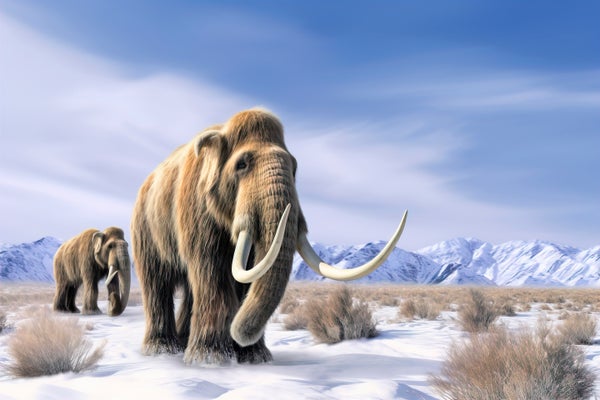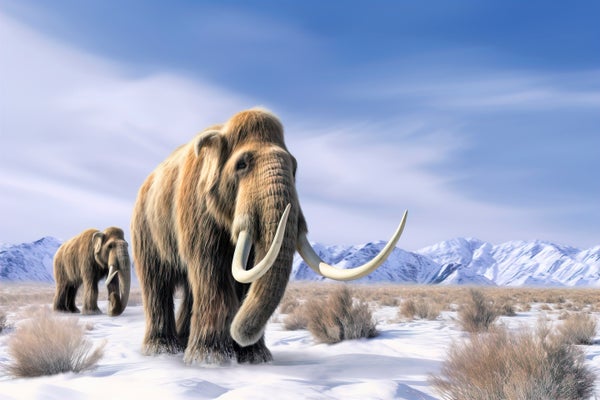A Freeze-Dried Woolly Mammoth Has Yielded the First Ever Fossilized Chromosomes
For the first time, researchers have reconstructed the 3D structure of ancient genetic material, in this case from a 52,000-year-old mammoth

Leonello Calvetti/Science Photo Library/Getty Images
For the first time, scientists have mapped the three-dimensional structure of preserved DNA from an ancient animal: a 52,000-year-old freeze-dried mammoth found sporting a mulletlike hairdo. This advance, published in Cell, let a transatlantic research team piece together the mammoth’s genome with unprecedented accuracy, as well as detect traces of past gene activity in the creature’s cells.
Ancient DNA usually appears in short, scattered snippets. It is from these fragments that researchers have identified new species of early humans, rewritten the history of horse domestication and uncovered why and when creatures such as the cave bear went extinct. But where previous efforts recovered shuffled pages from the book of life, the current one captures an ordered stack with dog-eared corners.
“This new work opens up major new possibilities of exploring the biology of extinct species,” says Adrian Lister, a paleontologist at the Natural History Museum in London, who was not involved in the research. “[It] is an astonishing study.”
On supporting science journalism
If you’re enjoying this article, consider supporting our award-winning journalism by subscribing. By purchasing a subscription you are helping to ensure the future of impactful stories about the discoveries and ideas shaping our world today.
For more than a century, many geneticists have doubted shapes such as these could be preserved in fossils. In living creatures, DNA molecules twist and coil as certain genes turn on and others switch off. After organisms die, however, these molecules begin to shatter, generating fragments that travel across space like dye in water. The DNA in the mammoth sample fragmented but did not disperse: the pieces ran into a rare molecular traffic jam, so they hovered in place, keeping intact chromosome structures as tiny as 50 nanometers across.
The team suspects that the sample, a strip of skin taken from near the mammoth’s ear, held up so well because it underwent spontaneous freeze-drying. Soon after the mammoth died, permafrost blanketed its body. The low temperature of the tundra slowed the motion of its molecules, and dehydration caused by the tundra’s dry atmosphere meant there was no water available for the DNA fragments to move through, leaving the leathery sample more shelf-stable than the average supermarket snack.
To recover the precise features of the mammoth’s chromosomes, the researchers modified a procedure known as Hi-C to map sections of DNA that were in contact with one another. The mammoth’s genetic material clustered into 28 pairs of chromosomes, which is the same number found in its living descendants, Asian and African elephants. This was a positive sign that the method produced trustworthy results. The team then zoomed in further, assembling the DNA sequence for the full genome and assessing more subtle variations in the chromosomes’ shapes. By comparing the woolly mammoth’s chromosomal compartments with those in its nearest relative, the Asian elephant, the researchers identified hundreds of genes that functioned differently in the two species’ skins and pinpointed a cluster that was partially responsible for the mammoth’s iconic hairiness and ability to brave the cold.
One gene called EGFR, for instance, was inactive in the mammoth but active in the Asian elephant. Previous experiments showed that suppressing this gene in both humans and sheep produces unruly hairiness. (Over time, woolly mammoth fossils tend to lose their hair. The specimen under study, however, flaunted a mullet, earning it the nickname “Chris Waddle,” after a famous British soccer player with a similar hairstyle.)
Outside of these mammoth-specific revelations, the study highlights just how much genetic information fossils can contain, says study co-author Erez Lieberman Aiden, a geneticist at the Baylor College of Medicine. In addition to the analysis on Chris Waddle, the team tested its procedure on another well-preserved mammoth sample and found large-scale chromosomal structures, though not smaller ones.
The researchers aren’t sure how likely it is that other fossils, mammoth or not, could have remained as unperturbed as the 52,000-year-old specimen. But they suspect that a range of circumstances could produce the necessary molecular conditions, including the hot air-drying involved in mummification. By experimenting on various types of beef, the scientists found that fresh meat would lose its chromosomal structure after three days at room temperature. Beef that was dehydrated, however, either by heat or freeze-drying, retained this structure for over a year. And these old, dried samples were so hardy that they survived being run over by a car, hit by a fastball and dipped in acid. (“After a year [of experimentation], we started to get a bit stir-crazy,” Aiden says.)
Aiden hopes the study will pave the way for scientists to identify other samples ripe for this type of study. “I’m optimistic that there’s a lot more of this out there,” he says. The team calculates that the modified Hi-C protocol could even work on specimens up to two million years old: the threshold at which the letters in the “text” of the genome becomes unreadable.
Study co-author Juan Rodríguez, a geneticist at the University of Copenhagen, imagines that widespread use of the technique could generate more precise ancient genomes and allow analysis of new species. When examining DNA snippets from an ancient specimen, scientists typically guess at the order of the fragments based on the genome of the extinct creature’s closest living relative. This approach helps plug a large gap in knowledge, but it also glosses over important distinctions between ancient and modern species. And it breaks down altogether in scenarios where the modern species has diverged significantly from the ancient one or where the ancient species lacks a modern descendant, as is the case with woolly rhinoceroses and saber-toothed cats, respectively. The new 3D structural analysis bypasses these obstacles. Future work could flesh out evolutionary trees, Rodríguez suggests, or examine how organisms adapted to their changing environments, producing insights for modern conservation efforts.
“We probably can’t even foresee everything [the paper might lead to],” says study co-author Olga Dudchenko, a computational biologist at the Baylor College of Medicine. Since its advent in the 1980s, the field of paleogenomics has expanded in ways scientists couldn’t have imagined, she adds. The researchers hope that peers who work on other creatures might find their own Chris Waddles.

